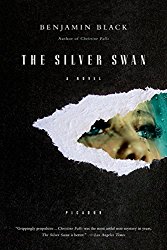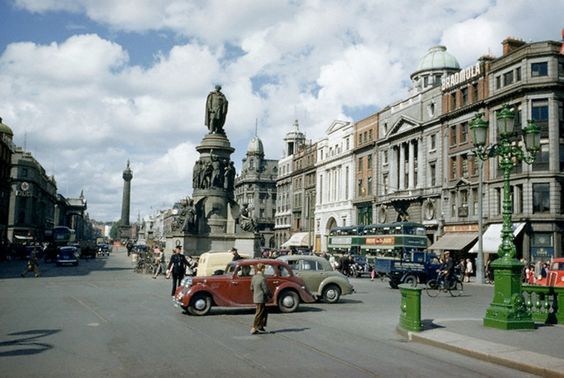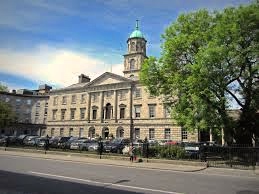NOTE: The second of the “Quirke series” by Benjamin Black (the pen name used by renowned author John Banville for his mystery novels), The Silver Swan (2008) follows Christine Falls (2007). At present (January, 2017) there are seven Quirke novels in this series, which is set in the 1950s. Quirke’s complex personal story unfolds very slowly in the background during these seven novels, some of it especially important to understanding him, though it is referenced, but not usually explained, in subsequent novels. I am therefore reposting these early reviews because they introduce key information in Quirke’s life, important to know in later novels, including Even the Dead, published on Jan. 3, 2017 and also reviewed here.
“Everywhere he turned in the business of Deirdre Hunt, things that had seemed substantial evaporated into smoke and air, and what had appeared open and inviting entryways were suddenly slammed shut in his face.”

Booker Prize-winning author John Banville, writing as Benjamin Black, began an intriguing mystery series in 2007 with Christine Falls, featuring Quirke, a pathologist at the Hospital of the Holy Family in Dublin. Quirke often finds himself called upon to do more than a pathologist is usually required to do, and in this second novel in the series, he is visited by Billy Hunt, a casual friend from college, who asks him not to do an autopsy on the body of his wife Deirdre, which has been found on a small island off the coast of Dublin. Deirdre may have been a suicide, and this is Dublin in the 1950s. The Catholic Church is dominant as a social and judicial force, and Hunt does not want his wife to be denied the benefits of a Catholic burial. Quirke is vulnerable to persuasion. He experienced the power of the church and its control of social and political policy-making two years ago when he investigated the death of a young woman, Christine Falls, after an abortion (the subject of Black/Banville’s first novel). It was then he discovered that not only was his “brother,” Dr. Malachy Griffin involved, but that his “father,” Judge Garret Griffin was an even more important player.
Quirke owes much of his present life to Judge Griffin, who unofficially adopted him when he was a young orphan. Sharing the Judge’s attention with his real son, Malachy Griffin, Quirke was grateful for the care, love, and education he received from the Judge. Nevertheless, Quirke followed what he believed to be right in the Christine Falls case, nearly destroying the lives of both the Judge and Malachy in the process. Though the author is careful to include some explanation about the past in this novel, including the reasons for his estrangement from his daughter, it is complex and not fully explained, much more easily understood by those who have read Christine Falls—and a reason for those who enjoy this book to read the earlier one for background (and another good story).

The body of Deirdre Hunt was found on a small island off the coast of Dublin, perhaps Lambay Island, here, just four kilometers from the coast.
Despite his promise to Billy Hunt, Quirke obeys his hunch and, during the autopsy that he performs quietly, he discovers an injection mark, an observation he keeps to himself. A verdict of accidental drowning is given officially, and Quirke then begins his investigation into the real cause of her death—accident, suicide, or murder. Through flashbacks and shifts in the point of view from Quirke to the other characters involved in Deirdre Hunt’s story, her complicated life unfolds. Deirdre, a young woman who grew up poor, is shown as a young woman with a head for business, and when Leslie White, an attractive, silver-haired man, suggests that they become partners in a beauty salon, which they name The Silver Swan, she accepts. At the same time, she also explores the “spiritual healing” of Dr. Hakeem Kreutz, who is involved in illegal activities. Soon Deirdre finds herself becoming more and more controlled by Leslie White and Kreutz, less able to make decisions, less grounded in reality—and less aware of the financial problems of her business.
As each character’s point of view allows him/her to expand the story of Deirdre, the characters grow, and Quirke himself becomes more fully developed. His relationship with a woman estranged from her husband is both complex and sensitively explored by the author in some intense scenes. At the same time, through flashbacks, Deirdre demonstrates her increasing sexual dependence on Leslie, leading to some graphic, even explicit, interludes. When Quirke’s daughter Phoebe becomes involved with the same Leslie and Kreutz, the drama of Deirdre Hunt and her life hits home with Quirke. The nightmarish atmosphere becomes increasingly fraught, as the characters explore their sexual feelings and deal with their guilt. Their separate points of view are given full play, and as the action leads to a fierce crescendo (and a somewhat ambiguous epilogue), the author also opens several new avenues for future novels.

1953, Dublin, Ireland. Statue of Daniel O’Connell. Click to enlarge. Photo by Maynard Owen Williams/National Geographic Society/Corbis
As much about Quirke as it is about the mystery of Deirdre Hunt, this novel, like Christine Falls, depends to a great extent on coincidence and improbabilities for its action and resolutions. Quirke is an engaging and sympathetic protagonist, however. Sober for six months when this novel opens, he continues to struggle every day with the “pub mentality,” and longs to become closer to his daughter, though he recognizes that he has no right to this affection. His honesty is tempered by his acknowledgment that sometimes “justice” is better served when one takes private action–or no action at all. Banville’s talents, so obvious in his literary novels, are on full display here. His descriptions enliven the physical depiction of Dublin and the atmosphere, and his recognition of life’s ethical subtleties (and the church’s creation of some of those conflicts) gives thematic punch to the novel. A fine addition to this continuing series, The Silver Swan adds to the Benjamin Black oeuvre.
ALSO by Benjamin Black: CHRISTINE FALLS (Quirke), THE BLACK-EYED BLONDE (Raymond Chandler), DEATH IN SUMMER (Quirke), VENGEANCE (Quirke) EVEN THE DEAD (Quirke)
Photos, in order: The author’s photo is from http://www.bbc.co.uk/
Lambay Island, just four kilometers off the coast, resembles the description of the island where Deirdre Hunt’s body was found. It is the easternmost point of the Republic of Ireland: http://www.dublinbaycruises.com/
The Rotunda Hospital in Dublin has been operating since 1745. http://curiousireland.ie
The 1953 photo of Dublin, by Maynard Owen shows the statue of Daniel O’Connell facing the street bearing his name. Williams/ National Geographic Society/ Corbis. https://www.pinterest.com


